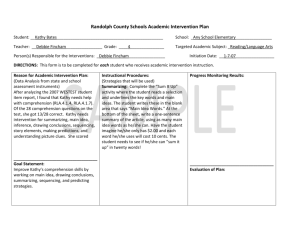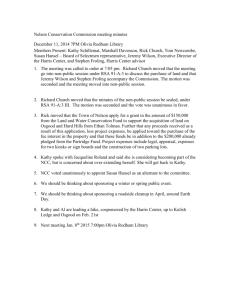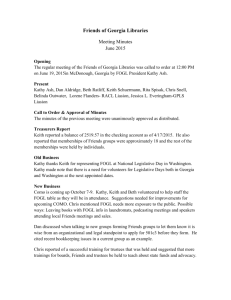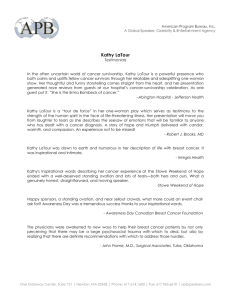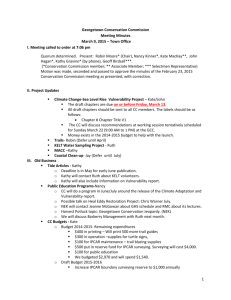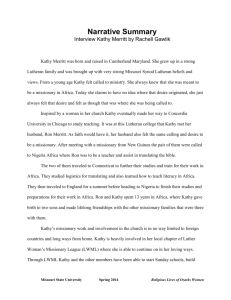ROUND TABLE STRATEY The following sheet explains a strategy
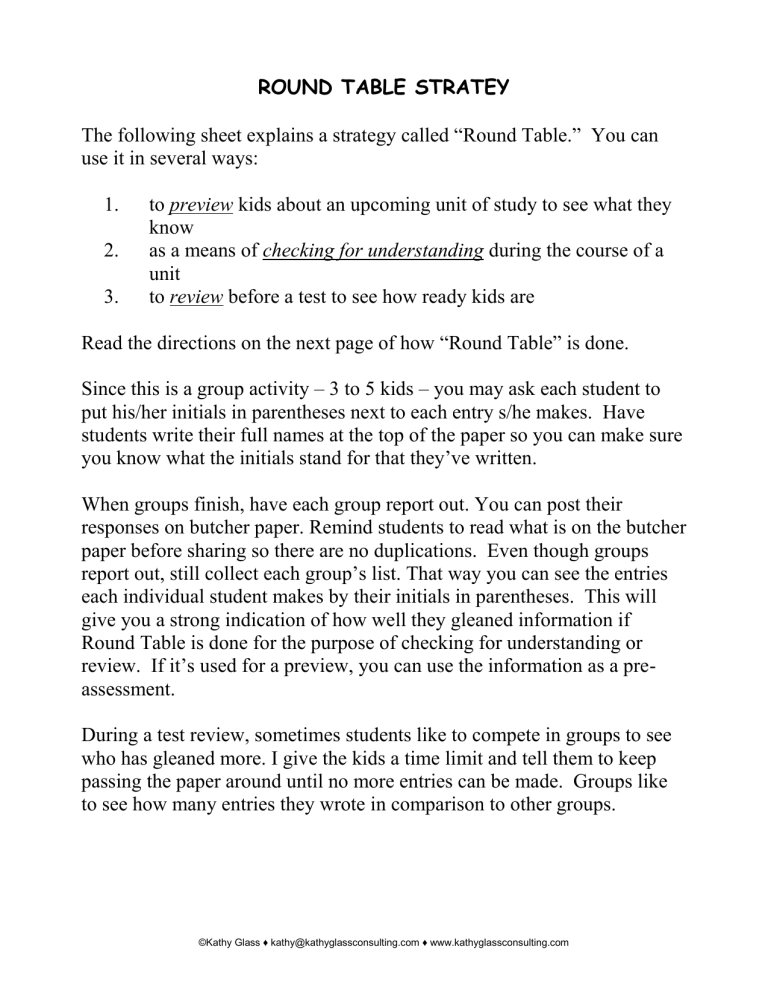
ROUND TABLE STRATEY
The following sheet explains a strategy called “Round Table.” You can use it in several ways:
1.
to preview kids about an upcoming unit of study to see what they know
2.
as a means of checking for understanding during the course of a unit
3.
to review before a test to see how ready kids are
Read the directions on the next page of how “Round Table” is done.
Since this is a group activity – 3 to 5 kids – you may ask each student to put his/her initials in parentheses next to each entry s/he makes. Have students write their full names at the top of the paper so you can make sure you know what the initials stand for that they’ve written.
When groups finish, have each group report out. You can post their responses on butcher paper. Remind students to read what is on the butcher paper before sharing so there are no duplications. Even though groups report out, still collect each group’s list. That way you can see the entries each individual student makes by their initials in parentheses. This will give you a strong indication of how well they gleaned information if
Round Table is done for the purpose of checking for understanding or review. If it’s used for a preview, you can use the information as a preassessment.
During a test review, sometimes students like to compete in groups to see who has gleaned more. I give the kids a time limit and tell them to keep passing the paper around until no more entries can be made. Groups like to see how many entries they wrote in comparison to other groups.
©Kathy Glass ♦ kathy@kathyglassconsulting.com ♦ www.kathyglassconsulting.com
Let’s Review
1. Take out one piece of paper per group.
2. Each group member is to have a pen or pencil.
3. Raise your hand if your birthday is closest to
____________. You are first. The person on your left is 2 nd and so on.
4. Starting with the first person, write down one word or phrase that you learned during our study of __________________________.
5. Continue to pass the paper around entering one word or phrase that you learned about this topic.
6. No duplications are allowed, so read all the previous entries before writing yours. You are entitled to pass when the paper comes to you.
7. Time limit: _______________.
©Kathy Glass ♦ kathy@kathyglassconsulting.com ♦ www.kathyglassconsulting.com
What do you know about…?
1. Take out one piece of paper per group.
2. Each group member is to have a pen or pencil.
3. Raise your hand if your birthday is closest to
____________. You are first. The person on your left is 2 nd and so on.
4. Starting with the first person, write down one word or phrase that you know about
_______________.
5. Continue to pass the paper around entering one word or phrase that you know about the topic.
6. No duplications are allowed, so read all the previous entries before writing yours. You are entitled to pass when the paper comes to you.
7. Time limit: _______________.
©Kathy Glass ♦ kathy@kathyglassconsulting.com ♦ www.kathyglassconsulting.com
adventurous anxious boisterous carefree clumsy congenial daring dishonest entertaining fierce haughty humane impatient innocent inventive keen listener mercurial naughty outlandish peace-maker radiant rowdy sensitive skillful stubborn timid trustworthy unaware unruly villainous wholesome
Character Traits lively modest nimble overbearing pessimistic reasonable sarcastic supercilious
(patronizing, arrogant) sociable suspicious timid tyrant unfaithful unwise vivacious wise aggressive appreciative braggart careless comical courageous determined distrustful evil gregarious helpful humble impish insincere irresistible knowledgeable agreeable bitter brutal cautious confident cowardly dignified energetic exceptional gullible heroic ill-tempered incompetent intelligent irresponsible lazy loving morbid obnoxious parsimonious poised rebellious secretive sentimental spiteful taker tormenter unconcerned ungrateful upbeat vulgar witty aloof bloodthirsty capable clever confused cruel discontented energetic enthusiastic harsh hopeful imaginative ingenious intrusive irritable lethargic loyal mysterious optimistic passive practical reckless self-centered sincere spontaneous thrifty treacherous under-achiever unique vain weak-willed woeful
©Kathy Glass ♦ kathy@kathyglassconsulting.com ♦ www.kathyglassconsulting.com
A figure of speech in which non-human objects or animals are given human qualities.
Examples:
- Hunger sat shivering on the road .
- Flowers danced about the lawn.
A figure of speech in which two essentially unlike things are compared using like, as , as if, or resembles.
Examples:
- Her hair is like slimy rope.
- She was as scared as a mouse when it sees a hungry snake.
A figure of speech in which two essentially unlike things are compared NOT using like or as .
Examples:
- Her nose is a pointed hat stuck on her face.
- The leaves were a carpet covering the lawn .
Similes, metaphors and personification are forms of figurative language – or figures of speech. An author uses figurative language to give the reader a new and fresh way of looking at something. The author has a purpose in using figurative language: he or she wants the reader to understand what s/he has written more clearly and leave an impression on the reader. A good use of figurative language will leave the reader thinking, “Wow! This is a great way to express that!”
©Kathy Glass ♦ kathy@kathyglassconsulting.com ♦ www.kathyglassconsulting.com
SIMILE
Definition:
A comparison between two unlike objects, ideas, or things using like, as if, as, seems, or resembles.
Formula:
A is like B
A
Examples:
The ice
B (ice is compared to wasp)
on my skin stung like a wasp.
A B (kisses are compared to candy)
Your kisses
are as sweet as candy.
Directions:
Determine what two things are being compared in the similes listed in the chart below. Then, fill in the A and the B to show these two comparisons:
Sentence Using Simile A B
Her eyes are like diamonds . eyes diamonds
Her voice is as loud as a trumpet . voice trumpet
Newly planted flowers are like babies, fragile and soft.
The ballerina dances as gracefully as a swan.
The taxi driver weaves through traffic like a snake.
Debra’s joke is as funny as a funeral service.
Name:
_________________________________________
©Kathy Glass ♦ kathy@kathyglassconsulting.com ♦ www.kathyglassconsulting.com
WHICH ARE SIMILES?
1 = Simile
●
2 = Not a Simile
●
Fist = I’m not sure.
1.
Her eyes are like diamonds because they sparkle and shine.
2.
Sally’s teeth are as straight as rows of cans neatly lined up on a grocery shelf.
3.
Jose and Karen like to eat peas.
4.
Raindrops falling on leaves are teardrops of nature.
5.
The small puddle is an ocean to ants.
6.
The sound of the typewriter keys is like the hammering of many nails.
7.
Large maple leaves are giant hands.
8.
He hugged me as I was crying.
©Kathy Glass ♦ kathy@kathyglassconsulting.com ♦ www.kathyglassconsulting.com
♥ SIMILES ♥
Directions:
Below is a list of similes found in Tuck Everlasting.
Read each one carefully and write down the two things being compared. Avoid writing down too much. See the example on the first line to guide you.
Simile
“Proud as peacocks, all of
‘em.”
(p. 77)
“I’m about dry as dust.”
(p. 29)
What two things are being compared?
The Tucks peacocks
“Her backbone felt like a pipe full of cold running water...”
(p. 32)
“The sweet earth opened out its wide four corners to her like the petals of a flower, ready to be picked.”
(p. 45)
“…Queen Anne’s lace lay dusty on the surface of the meadows like foam on a painted sea.”
(p. 47)
Name:
_________________________________________
©Kathy Glass ♦ kathy@kathyglassconsulting.com ♦ www.kathyglassconsulting.com
Think of words that will fit into the blank below. Be ready to share your words.
The very ______ man
© Kathy Glass kathytglass@yahoo.com
17
ADJECTIVES
Adjectives describe nouns to give more information. If a word can fit into the blank in following phrase, then it ’ s an adjective.
The very ______ man
Numbers like forty and three are also adjectives but don ’ t fit into the phrase above.
© Kathy Glass kathytglass@yahoo.com
©Kathy Glass ♦ kathy@kathyglassconsulting.com ♦ www.kathyglassconsulting.com
18
© Kathy Glass kathytglass@yahoo.com
24
© Kathy Glass kathytglass@yahoo.com
©Kathy Glass ♦ kathy@kathyglassconsulting.com ♦ www.kathyglassconsulting.com
25
How is the rhythm in paragraph #1
different from
the rhythm in paragraph #2?
Paragraph #1:
June came with its endless rains. Day after day the sky was gray. Rain dripped steadily from the leaves. Everything in the room smelled musty. Even the sheets felt clammy. Sadako grew pale and listless. Only her parents and
Masahiro were allowed to visit her. The bamboo class sent a doll to cheer her up.
Adapted excerpt from Sadako and a Thousand Paper Cranes 32
How is the rhythm in paragraph #1
different from
the rhythm in paragraph #2?
Paragraph #2:
Mrs. Sadako was worried because her daughter didn ’t eat enough. Though she tried daily to feed her, one night she brought a surprise wrapped in a bundle, and Sadako was excited to see its contents.
It contained all of her favorite foods
– an egg roll, chicken and rice, pickled plums, and bean cakes.
Even though she propped herself up against the pillows, it was no use trying to eat.
33
Adapted excerpt from Sadako and a Thousand Paper Cranes
©Kathy Glass ♦ kathy@kathyglassconsulting.com ♦ www.kathyglassconsulting.com
COMPLEX SENTENCE DEFINITION
A complex sentence is the combination of a dependent clause and an independent clause.
Independent Clause + Dependent Clause =
Complex Sentence
►
Example: The air was already warm when the family started out.
Or
Dependent Clause + Comma + Independent Clause
= Complex Sentence
►
Example: When the family started out , the air was already warm.
An independent clause is the same as a simple sentence; therefore, it can stand alone.
A dependent clause depends on something else and cannot stand alone . It includes a subordinating conjunction, a noun, and a verb.
Example: When I was little…
©Kathy Glass ♦ kathy@kathyglassconsulting.com ♦ www.kathyglassconsulting.com
after
Common Subordinating Conjunctions
although as as if as long as as though because even though in order that only so that though until where while before if now that rather than than till when whereas even if if only once since that unless whenever wherever
©Kathy Glass ♦ kathy@kathyglassconsulting.com ♦ www.kathyglassconsulting.com
♥ IDENTIFYING DEPENDENT CLAUSES ♥
Directions: Below are complex sentences from the story Sadako and a Thousand
Paper Cranes.
Read each sentence. Then write the subordinating conjunction used in each sentence in column #1, and write the entire dependent clause of each sentence in column #2.
Sentence Subordinating
Conjunction
Dependent Clause
When the family started out, the air was already warm.
While she sat there, a fuzzy spider paced across the room.
When Sadako finally stopped sobbing, she looked out at the moonlit sky.
As Sadako grew weaker, she thought more about death.
©Kathy Glass ♦ kathy@kathyglassconsulting.com ♦ www.kathyglassconsulting.com
♣ IDENTIFYING DEPENDENT CLAUSES
Directions: Below are complex sentences from the story Sadako and a Thousand
Paper Cranes.
Read each sentence. Then write the subordinating conjunction used in each sentence in column #1, and write the entire dependent clause of each sentence in column #2.
Sentence Subordinating
Conjunction
Dependent Clause
Once the kitchen was clean and tidy,
Sadako tied red bows on her braids and stood impatiently by the door.
When the ceremonies were over, Sadako led the others straight to the old lady who sold cotton candy.
It was even more real when Nurse
Yamasunaga came in to give her a shot.
Sadako felt strong and healthy as she ran longer and faster.
©Kathy Glass ♦ kathy@kathyglassconsulting.com ♦ www.kathyglassconsulting.com
SOME WAYS TO BEGIN SENTENCES
SUBJECTS ADVERBS
PHRASES or
DEPENDENT CLAUSES
Pronouns: How?
after since he you loudly although though she they silently as unless it I carefully as if until we peacefully because whatever angrily before when
Nouns:
joyously
When?
even if even though whenever whether while car, sheet, tomorrow if once men, rock, yesterday in order to rather than dogs, desk, then pool
Proper
Nouns:
Mr. Smith,
Helen, Juan,
October now soon
Where?
there, here, nowhere
©Kathy Glass ♦ kathy@kathyglassconsulting.com ♦ www.kathyglassconsulting.com
RECIPROCAL TEACHING – Whole Class
Teacher: Reads (lectures on) one paragraph or section aloud and then asks students to create two good questions about the reading selection on scratch paper. Students ask their questions as teacher records selected questions on overhead or butcher paper. (It’s a brief reading section, so there will be few questions; many students will have the same questions.)
● Class: Students review questions on overhead and write the answers to any question they can on their scratch paper.
Teacher: Instruct students to turn to their neighbors and review answers to questions. If they disagree with an answer, they are to circle it and share it with the class for discussion.
● Class: Students answer the questions or ask the teacher/another student for clarification. At this point, all questions on overhead should be answered.
Class and Teacher:
Review the questions and identify the most important ones that represent the reading.
Predict what will happen next in the reading; clarify, as needed.
Teacher: Summarize reading material for class.
● Class: In their journals, students write a summary of the reading selection and add to the teacher’s oral summary, as needed.
Individual
Assessment Options:
Write a summary individually or in pairs.
Complete a quiz.
Complete “Read for Meaning.”
Write an exit card based on teacher instructions.
Write salient points in student journals.
©Kathy Glass ♦ kathy@kathyglassconsulting.com ♦ www.kathyglassconsulting.com
RECIPROCAL TEACHING – In Pairs
The goal of RT is flexible and independent use of these four reading comprehension strategies: questioning, summarizing, clarifying, predicting
. Ultimately, students should become so familiar with the RT strategies that they use them in any situation whenever they are of help. The following is a typical discussion pattern for Reciprocal Teaching among pairs.
Student A:
Reads one paragraph or section aloud and then asks Student B two good questions about the reading selection.
Student B:
Answers the questions or asks for clarification.
Students A and B:
Discuss reading selection.
Student A:
Summarizes reading material for B and then asks B to add to the summary.
Students A and B:
Predict what will happen next in the text.
---Exchange roles and repeat---
Student B:
Reads one paragraph or section aloud and then asks Student A
Student B: two good questions about the reading selection.
Student A:
Answers the questions or asks for clarification.
Students A and B:
Discuss reading selection.
Summarizes reading material for A and then asks A to add to the summary.
Students A and B:
Predict what will happen next in the text.
This strategy can be done in small groups, too. With small groups, the discussion leader (a teacher or student) generates questions and the group responds. The leader invites other members of the group to ask additional questions, if they have them. The leader then summarizes the text and asks other members if they would like to elaborate upon or revise the summary. Necessary clarifications may be discussed throughout the dialogue or all at once. Finally, in preparing for moving on to the next portion of the text, the group makes predictions. The role of the discussion leader can be rotated among group members.
Assessment Choices: Students individually or in pairs write a summary, prediction,
“Read for Meaning,” or exit card.
©Kathy Glass ♦ kathy@kathyglassconsulting.com ♦ www.kathyglassconsulting.com
HOW IS INFERENCE A USEFUL READING STRATEGY?
● ● ● ● ●
Lesson 1.2: How can I make inferences in reading?
Lesson Overview: In this lesson, students read a letter or story and employ the strategy of inference by using hints from the letter or story to draw conclusions. They support their conclusions with evidence from the text along with their own impressions.
Resources:
“Hi, Marge!” letter (provided)
“Conclusions: Peg” (provided)
The Treasure – picture book (provided)
“Conclusions: The Treasure” (provided)
► TEACHER PREPARATION: Arrange students homogeneously by ability level. Read both the
“Hi, Marge!” letter and “The Treasure.” Decide which one is appropriate to use for different groups or use the same one for the whole class. “Hi, Marge!” is a more sophisticated text. Copy
“Conclusions” for whichever text you choose to use onto cardstock (100 lb. paper), laminate, and cut each sentence into a strip. Read this lesson to help determine how many sets of strips to make.
Lesson Details:
1. Set the stage.
Say to students: “Earlier we reviewed pictures and discussed how we can make inferences through the details in the picture and our own background knowledge. Making intelligent inferences during and after reading can make you better readers. Readers make inferences in many ways. One way to make inferences is by using hints from the author to draw conclusions. Effective readers use the information in the text to draw conclusions and form interpretations. Today we will practice making inferences by reading and using the author’s words to draw conclusions.”
2. Read and determine appropriate conclusion.
Determine if you will use Peg or The Treasure.
Say the following to students:
“I will read a letter to a girl named Marge from a classmate whose name is Peg (or a story called The Treasure) . After reading the letter (or story) , you will read a number of possible conclusions that a reader might make based on the words of the author, and your own impressions. Read the conclusions in small groups and decide which ones seem most appropriate. Then, talk with your group to answer the questions at the bottom of the letter about your chosen conclusions. See if you can find one or two of the best conclusion statements to sum up the reading.”
Distribute a copy of the letter or the story for students to follow along as you read aloud. See the questions that students address at the bottom of both texts.
►
Differentiation: Ask high achieving students to create their own conclusions instead of using the ones you have prepared. They still test their conclusions against the same set of questions as the others used. Distribute an appropriate amount of conclusion strips to students based on their ability levels. Therefore, do not give all 12 strips to struggling learners but rather select four or five for them to study carefully. Alternative: Do not read either the letter or story aloud. Rather, give Peg to high achievers to use as the basis for the activity and “The Treasure” to other students. Provide adult assistance at groups, as necessary.
3. Debrief.
Students share their selected or invented conclusions with the whole class and support them through the questions. Re-emphasize the point that one way readers infer is through making reasonable conclusions drawn from hints the author provides.
ASSESSMENT: Observations of participation in group activity and discussions
©Kathy Glass ♦ kathy@kathyglassconsulting.com ♦ www.kathyglassconsulting.com
Hi, Marge!
I’m awfully sorry to hear you’ve been sick and in the hospital for two weeks.
I’ve been meaning to come see you – I really have – but I’ve been terribly, terribly busy. Did you know I replaced you in the school play? Rehearsals are a blast!
I suppose you’re living a life of luxury – nurses to wait on you hand and foot, good-looking doctors to watch over you. Gee, some people have all the luck! I guess a healthy little nobody like me just doesn’t rate.
I hope you don’t mind, but Eddie asked me to the prom. I saw him the other day and asked him who he was taking – I knew you couldn’t go. You probably won’t be able to do much more than resting and taking it easy for months.
Anyway, he said he’d asked Gloria. Now, I know you wouldn’t want him to take her
– you’d probably never see him again (ha, ha). So, I convinced him to take me. I’m sure you’d prefer that he took a friend of yours.
Could I ask you a tiny little favor? Could I wear the dress you bought for the prom? After all, it won’t do you any good just hanging in the closet. And pink is the color that looks best on me.
Seriously, I hope you get better soon.
Do you think you’ll be able to rejoin the cheerleading squad this year?
Love,
Peg
After Reading…
1. Is the conclusion statement clearly supported in the letter?
2. Is this conclusion statement something a reader would guess from reading the letter?
3. Does this conclusion statement seem untrue from reading the letter?
4. Is there anything in the letter to support whether or not this conclusion statement is true or false?
5. What is a character trait to describe Peg? What evidence do you have from the letter to support this trait?
Source: Projection in Literature (Scott, Foresman, 1967), pg. 526
©Kathy Glass ♦ kathy@kathyglassconsulting.com ♦ www.kathyglassconsulting.com
Conclusions: Peg
1. Peg is really concerned about Marge’s illness.
2. Peg is jealous of Marge.
3. Peg has probably never been in a hospital.
4. Peg has no sympathy for others.
5. Peg would like to be in a hospital herself.
6. Peg is very shy with people.
7. Peg is forward with other people.
8. Peg thinks of herself as not very important.
9. Peg would like to be important.
10. Peg is very practical and doesn’t like to see anything go to waste.
11. Peg takes advantage of her friends.
12. Peg would like to replace Marge as a cheerleader.
Source: Projection in Literature, pg. 526, Scott Foresman © 1967
©Kathy Glass ♦ kathy@kathyglassconsulting.com ♦ www.kathyglassconsulting.com
The Treasure
By Uri Shulevitz
There once was a man named Isaac. He lived in such poverty that again and again he went to bed hungry.
One night he had a dream. In his dream, a voice told him to go to the capital city and look for a treasure under the bridge by the Royal Palace.
“It is only a dream,” he thought when he woke up, and he paid no attention to it.
The dream came back a second time. And Isaac still paid no attention to it. When the dream came back a third time, he said, “Maybe it’s true,” and so he set out on his journey.
Now and then, someone gave him a ride, but most of the way he walked.
He walked through forests. He crossed over mountains.
Finally he reached the capital city. But when he came to the bridge by the
Royal Palace, he found that it was guarded day and night. He did not dare to search for the treasure. Yet he returned to the bridge every morning and wandered around it until dark.
One day, the captain of the guards asked him, “Why are you here?” Isaac told him the dream.
The captain laughed. “You poor fellow,” he said, “what a pity you wore your shoes out for a dream! Listen, if I believed a dream I once had, I would go right now to the city you came from, and I’d look for a treasure under the stove in the house of a fellow named Isaac.” And he laughed again.
Isaac bowed to the captain and started on his long way home. He crossed over mountains. He walked through forests. Now and then, someone gave him a ride, but most of the way, he walked.
At last he reached his own town. When he got home, he dug under his stove, and there he found the treasure. In thanksgiving, he built a house of prayer. Isaac sent the captain of the guards a priceless ruby. And for the rest of his days he lived in contentment and he never was poor again.
After Reading…
1. Is the conclusion statement clearly supported in the story?
2. Is this conclusion statement something a reader would guess from reading the story?
3. Does this conclusion statement seem untrue from reading the story?
4. Is this the best conclusion statement to sum up the real meaning of the story?
©Kathy Glass ♦ kathy@kathyglassconsulting.com ♦ www.kathyglassconsulting.com
Conclusions: The Treasure
1. Sometimes one must travel far to discover what is near.
2. People should appreciate what they have at home.
3. Life is full of surprises.
4. Leave home to find your dreams.
5. Dreams always come true.
6. Poverty can be cured by following dreams.
Note to teacher: Conclusion #1 above is actually written in the story, but I omit it for this exercise.
©Kathy Glass ♦ kathy@kathyglassconsulting.com ♦ www.kathyglassconsulting.com
